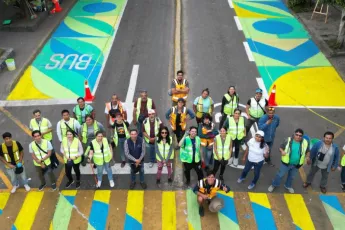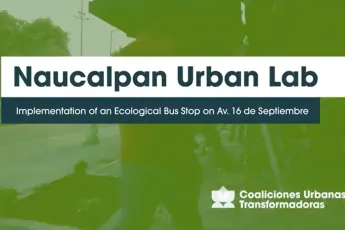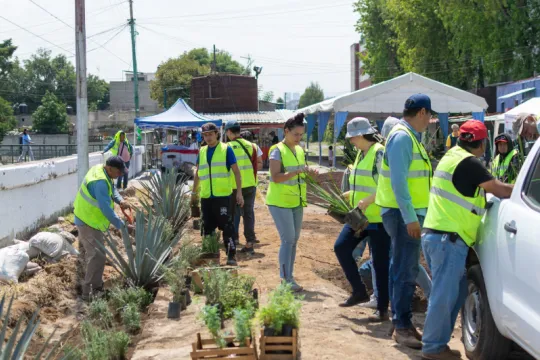
Volunteers who participated in the delimitation of pedestrian crossings and boarding and alighting areas, using a tactical urban planning intervention. © Erik Cisneros
Naucalpan de Juárez, in the State of Mexico, is part of the Metropolitan Zone of the Valley of Mexico (ZMVM) and borders two municipalities of Mexico City. This municipality is among those that generate and attract the most trips in the region, with more than one million daily trips during weekdays. More than half of these trips are made by public transport, and 15.9 per cent are associated with care work, mainly performed by women who travel on foot.
Mobility challenges and climate change
87 per cent of the vehicle fleet in Naucalpan is motorized, significantly contributing to greenhouse gas emissions (GHG). In 2014, the transportation sector generated 52 per cent of total GHG emissions in the municipality. In addition, an air quality diagnosis in 2021 identified high ozone and nitrogen dioxide concentrations generated by mobile sources, exceeding the recommended limits and posing risks to public and ecosystem health.
Experimental project: Ecological Bus Shelter
The Naucalpan Urban Lab developed four low-cost and easy-to-implement experimental projects to address these issues. One of these projects was constructing and installing an ecological bus shelter on Av. 16 de Septiembre, a street connecting primary roads with commercial and service areas.
Bus Shelter features
The bus shelter was installed in front of a family medicine clinic. It was designed based on needs and demands identified in surveys with users and meetings with representatives of transport companies, local mobility and traffic authorities and members of the Citizen Participation Councils (COPACI). It includes a green roof with low-maintenance vegetation, a large cover to provide shade, and a rainwater collection system to water the vegetation. It also includes an accessible space for people with reduced mobility, a bench, and a swing as a recreational element. In addition, pedestrian crossings and boarding and alighting areas for public transport were delimited through tactical urban planning actions.
Evaluation and results
Following the installation of the bus shelter, a traffic operation exercise was conducted to measure the impacts on air quality using low-cost monitors. The results showed a significant reduction in PM2.5 levels. According to a socio-environmental assessment survey, users highlighted the increase in shade, the good location, the ecological design and the improvement in air quality. More than 95 per cent of respondents believe the model should be replicated in other municipality areas.
Importance of infrastructure for sustainable public transport
This project demonstrates the importance of comprehensively developing innovative and sustainable solutions that address mobility and environmental issues. Public transport is crucial for mitigating climate change, promoting gender equity, and reducing GHG emissions and inequalities. A robust and equitable public transport infrastructure is essential for social and environmental sustainability.

